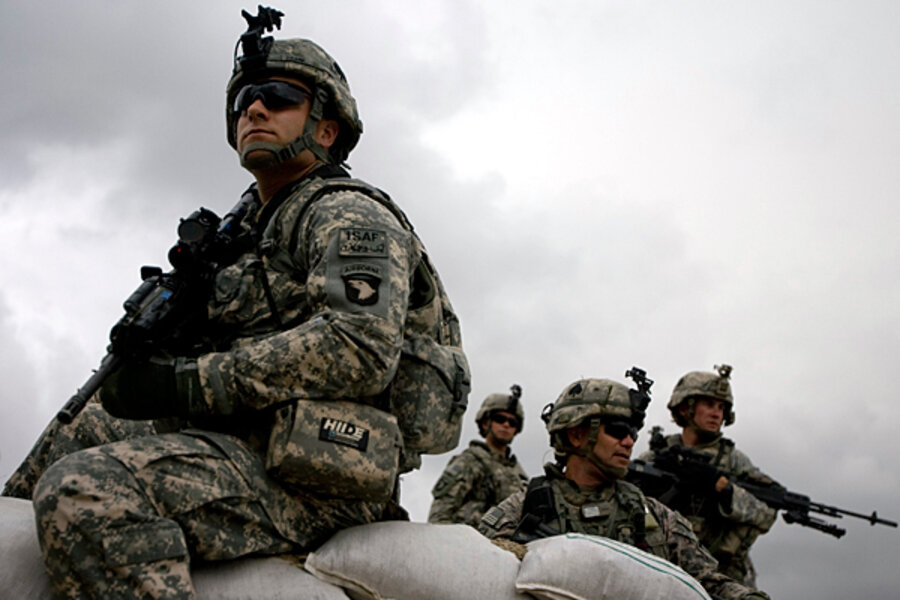Afghanistan war: how a model province tumbled into violence
Loading...
| Washington
It wasn’t long ago that Khost Province in eastern Afghanistan was a counterinsurgency success story for the US military. Journalists were encouraged to arrange reporting trips to the relatively calm showpiece region, but generally eschewed it in favor of areas where there was more fighting.
In the past two years of the Afghanistan war, however, violence in Khost has been on the rise as incidents of attacks and roadside bombings have crept upward.
Just what happened is something military analysts have been wrestling with for some time. This week, Col. Viet Luong, the US Army commander of the 3rd Brigade Combat team of the 101st Airborne Division, suggested that corrupt or inept local leadership combined with an influx of insurgents fleeing east from new NATO offensives in the south contributed to Khost's decline.
Colonel Luong, who assumed command of the area last January, told Pentagon reporters that there are some signs that security in Khost is improving to some extent. But assassinations of local Afghan officials are on the rise, and with other factors complicating the war effort, the region is years away from being ready to be turned over to Afghan security forces, he said.
One leading problem, he said, has been corruption – Afghan officials on the take.
“During my first several months, we had a guy that was corrupt,” said Luong, who added that he was able to convince the Afghan government to remove the official. But that official was “followed by a guy that was halfway illiterate.”
Then, “about six months ago, we were able to gain a very, very competent leader” along with 6,000 additional Afghan National Security Forces. That has yielded dividends, Luong said.
Luong points too to the influx of an additional 30,000 US troops into Afghanistan this year, which has allowed US and Afghan forces to have “increased fourfold” the number of operations in the adjacent provinces of Paktika and Paktia. This in turn has decreased the effectiveness of insurgent attacks, he said.
Still, there are some sizable strategic obstacles that the influx of US troops has not been able to solve. This includes the porousness of the mountainous Afghan border, which is 156 miles long in the Khost, Paktika and Paktia provinces, a region known as "P2K."
“As far as the border itself," Luong says, "I think it’s naïve to say that we can stop ... forces coming through the border.”
For this reason, the US military recently closed a combat outpost dedicated to intercepting insurgents on routes into and out of Pakistan. US troops are instead focusing on finding safe houses in Afghanistan, “where they have to train, they have to bed down, they have to store their caches. Predominantly our success has been there,” says Luong.
But it will be at least “the next couple years” before Afghan security forces will be able to take over security in the region from US troops, Luong says. And cooperation with the Pakistani military remains an as-yet unfulfilled goal, after a plan to do a joint insurgent clearing campaign last fall fell through.
That sort of collaboration has, “I will tell you, not gone that far yet,” says Luong, who adds that he is looking forward to greater Pakistani cooperation in the future. “We can,” he adds, “do better with that.”
One barrier to that cooperation could be Pakistan's enduring strategic interests in the P2K region. According to Jeffrey Dressler, a military analyst with the Institute for the Study of War in Washington, D.C., the majority of the mayhem in the three provinces is carried out by the Haqqani network, a group with particularly strong ties to Pakistan.
Pakistan’s intelligence agency, the ISI, “wants a reliable proxy that has territorial control of the P2K area,” Mr. Dressler adds. This desire is the result of Pakistan’s historic conflict with India. “If India comes across the border, Pakistan can fall back into Afghanistan and drive them out. It’s about strategic depth vis-à-vis India. As long as that continues to be a driving concern, Pakistan’s support for the Haqqani network will continue.”





